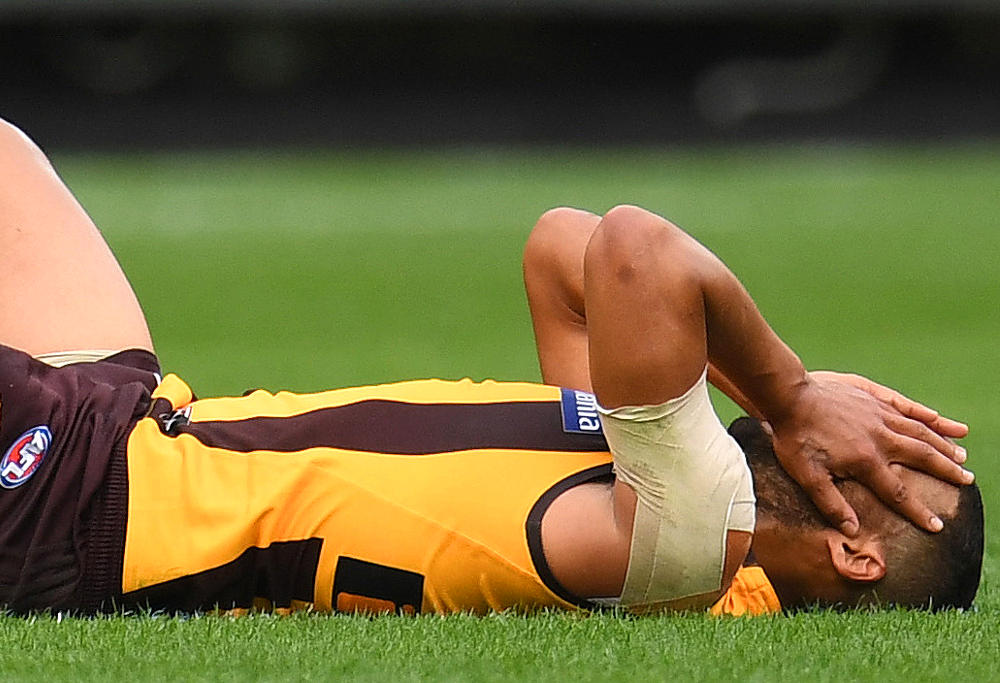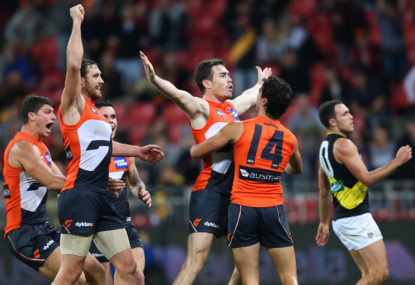In this series, I’ll investigate the science behind this divisive question alongside former elite NRL coach and trainer, Rohan Smith. First up, it’s Australian rules football.
In Round 7 of 2017, Greater Western Sydney’s Tom Scully – aerobic animal, the leanest footballer you’ve ever seen – spent 128 minutes and 13 seconds on field in one professional game. That’s more than two hours of constant running, sprinting, tackling and skill execution.
It is not unusual for AFL players to spend 100 per cent of game time on the ground.
However, the research suggests the best way to optimise a team’s collective effort is to use the interchange bench to rotate players on and off for short periods of rest.
Those players who do spend the full game on the ground tend to be big bodied forwards and defenders, so-called key position players who spend most of their time at one end of the ground.
Midfielders, generally ten centimetres or more shorter and anywhere from ten to 20 kilograms lighter on muscle, receive the lion’s share of the bursts of rest – particularly since the league introduced a cap on the use of the interchange.
Tom Scully is not a key position player. He is an outside midfielder with a listed weight of 79 kilograms, whose job is primarily to run across the ground and link up the play between the forward and back half. The interchange bench is made for him.
In the aforementioned fixture, Scully’s team (the GWS Giants) had been ravaged by injury. His freakish aerobic capacity meant he was relied upon to make up for his team’s reduced numbers on the bench.
Data on how far AFL players run in game is kept behind ethereal but impenetrable walls. A 2009 academic study produced by Catapault Sports, the Australian inventors and world leaders in wearable GPS technologies, found in their sample of 20 midfielders the average distance covered in a game was 17.5 kilometres (the range was 12.9 kilometres to 18.9 kilometres) in between 108 minutes and 114 minutes of active playing time.
Scully certainly ran more than that in his freakish outing. While he is the outlier, it’s clear that among major professional Australian sports, Australian rules football produces the athletes with the highest level of endurance.
On endurance, cricket and Australian rules football seem like chalk and cheese. But it’s not that simple. Rohan Smith agrees.
“One thing to consider in regards to endurance is what many performance staff call time on legs,” he said.
“While Test match cricketers have repeated running endurance for days at a time, the biggest endurance element to cricket is concentration, decision making and skill execution,” Smith said.
“The running element is significant, but overall given we are talking about the athletic component of endurance I would have to say the endurance of an AFL player is superior.”

(AAP Image/Julian Smith)
One of the downsides of this focus on the ability to run all game is strength – where in this instance AFL players only rank around the middle of the pack. The average AFL-listed players in 2017 weigh in at 85 kilograms; heavier than Scully, who at 79 kilograms sits comfortable in the bottom quintile of players by mass, but significantly lighter than both professional rugby codes.
These days, it is uncommon for a rugby union forward to weigh in under 100 kilograms, while most backs sit somewhere between the average AFL player and triple figures. This is, in most cases, muscle mass, not sheer size. Union’s monsters weigh in at 120 kilograms or more, the point at which muscle mass and general mass begin to blur into one.
Take now-Wallabies mainstay Israel Folau as an example. Folau was one of the GWS Giants’ inaugural players, making the switch from rugby league as a marketing tool to build some buzz around the heathen Western Sydney suburbs. According to the Daily Telegraph, Folau dropped seven kilograms in his first year as a Giant, playing at a still-large 98 kegs. Rugby.com.au now lists Folau at 103 kilograms.
As Rohan mentioned when we chatted about Australian rules players, they’re mostly sculpted with running endurance in mind; rugby players of both codes are built for heavier and more frequent collisions.
There is an interesting distinction to be made between professional athletes in Australian rules football and Association football (which will henceforth be dubbed soccer for ease of distinction). Both sports require a balance of speed, power and agility given they are what I termed ‘360 degree’ sports, as opposed to the more ‘front-facing’ attrition of the rugby codes or highly-structured interactions in cricket.
Despite both Australian rules football and soccer having many players of similar size and body shape – in the main, Aaron Sandilands could not play professional soccer – Rohan was of the view Australian football produced athletes with greater power and agility.
“There is a strength and power component in professional level soccer in Australia – but more isometric strength in holding people off rather than trying to throw them to the ground or physically dominate,” Smith said.
Key Information
Ryan and Rohan are making these judgments based on the highest level of domestic competition in each of the sports – except for cricket, where the Australian test team seems like the more appropriate comparator.
In this series, each sport will be ranked on key categories. We’ll reveal the final scores and the top sport at the end of the series.
Endurance: the length of time an athlete is required to perform at their peak, in a game and over the course of a season.
Power: how explosive an athlete needs to be, in both speed and strength terms, over and above the “resting” state of play.
Agility: a measure of an athlete’s required evasiveness, ability to change direction and be aware of those around them.
Speed: how fast is a player required to move around the field, both in sprints and general play.
Stay tuned for the next instalment when we’ll discuss cricket.
The full series
» Part One: AFL
» Part Two: Cricket
» Part Three: Rugby league
» Part Four: Rugby union
» Part Five: Football
» Part Six: Final Results
This series is sponsored by by POWERADE, fuelling rivalry through the POWERADE POWERSCORE. The Powerade Powerscore, developed in conjunction with the New South Wales Institute of Sport, allows you to compare yourself to mates and elite athletes.






























































































